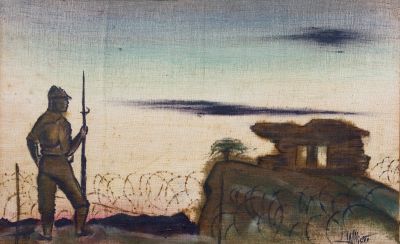Paintings from a POW camp
This story was written by Gail Delaney, the daughter of a Hong Kong prisoner of War. Her father, Mr. John "Jack" Burton was captured by the enemy in Hong Kong before his ship even docked. He spent four long years as a prisoner of war living in horrific conditions. But, in one of the prison camps, he created a friendship with a fellow prisoner and artist, Mr. William Allister.
Two paintings. Two lives. One shared experience. This story of 'prison camp art' proves that the human spirit cannot be crushed – even in its darkest moments.
As a 22-year-old in Toronto, my father, John Burton, joined the military in Toronto to see the world. In the fall of 1941, 1,975 Canadian Soldiers were sent to Hong Kong. After Japan's inevitable entry into the war, the leaders knew there was no hope of victory, nor of evacuation, nor of relief – and they were right.
On Christmas Day, seventeen days after the attack on Pearl Harbor, the massively outnumbered Allied troops admitted defeat. Of the Canadian troops, 290 had been killed, 1,675 had been taken prisoners of war. What they endured for the next 44 months in no way resembled the conventional definition of the term.
My dad was one of those POWs who rarely spoke of the four-year nightmare, only at times to guilt us into eating our supper because he could not tolerate waste -- especially when food was involved.
Another POW and friend of my dad's, William Allister from British Columbia, was an artist and writer. The paintings below are ones that William painted for my dad in 1942. He used a piece of tent canvas, bristles from a shoe brush wired onto a stick, and for paint he used crank case oil and cranberries for colouring.
One picture depicts their guarded housing units, and the other picture shows a sinking ship in Hong Kong Bay.
The paintings were well hidden until they dried. Then, my Dad rolled them up and sewed them into the inside of his pant leg where they stayed for over 3 years.
By the time of liberation in September of 1945, 267 of the POWs had died and the rest were barely clinging to a semblance of life.
The POWs were all shipped to Vancouver where they were hospitalized, and thoroughly evaluated mentally and physically. Upon dad's return to Toronto, he had the two canvases cleaned and framed. They hung over our living room couch all my life.
After both my parents passed away, I brought them to my home on Prince Edward Island where they still hang, above my living room couch, in silent memory.
- Date modified:

